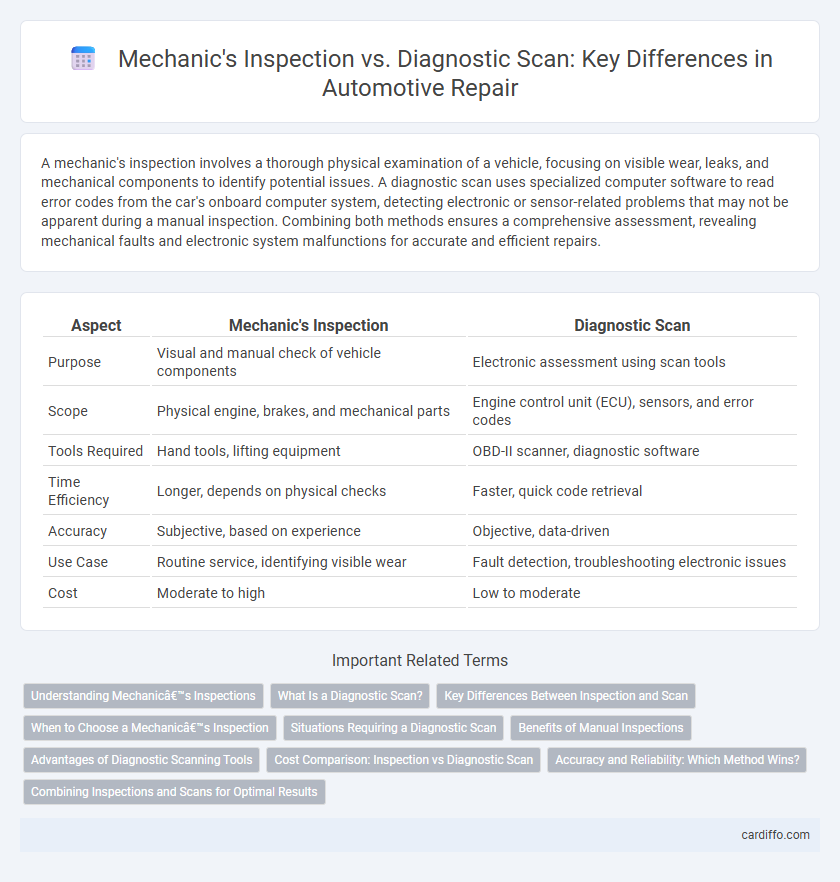A mechanic's inspection involves a thorough physical examination of a vehicle, focusing on visible wear, leaks, and mechanical components to identify potential issues. A diagnostic scan uses specialized computer software to read error codes from the car's onboard computer system, detecting electronic or sensor-related problems that may not be apparent during a manual inspection. Combining both methods ensures a comprehensive assessment, revealing mechanical faults and electronic system malfunctions for accurate and efficient repairs.
Table of Comparison
| Aspect | Mechanic's Inspection | Diagnostic Scan |
|---|---|---|
| Purpose | Visual and manual check of vehicle components | Electronic assessment using scan tools |
| Scope | Physical engine, brakes, and mechanical parts | Engine control unit (ECU), sensors, and error codes |
| Tools Required | Hand tools, lifting equipment | OBD-II scanner, diagnostic software |
| Time Efficiency | Longer, depends on physical checks | Faster, quick code retrieval |
| Accuracy | Subjective, based on experience | Objective, data-driven |
| Use Case | Routine service, identifying visible wear | Fault detection, troubleshooting electronic issues |
| Cost | Moderate to high | Low to moderate |
Understanding Mechanic’s Inspections
Mechanic's inspections involve a thorough physical examination of a vehicle's components, including brakes, suspension, and engine parts, to identify visible wear or damage. These inspections provide hands-on evaluation that can detect issues not always captured by a diagnostic scan tool. Understanding the scope and limitations of mechanic's inspections helps vehicle owners make informed decisions about necessary repairs and maintenance.
What Is a Diagnostic Scan?
A diagnostic scan is a computerized process that reads error codes from a vehicle's onboard computer system, pinpointing specific malfunctions in the engine, transmission, or other critical components. Unlike a mechanic's visual inspection, which relies on physical examination and experience, diagnostic scans provide precise data by interfacing with sensors and control modules to detect faults often invisible to the naked eye. This technology accelerates problem identification and ensures targeted repairs, minimizing guesswork and time spent on troubleshooting.
Key Differences Between Inspection and Scan
A mechanic's inspection involves a thorough physical examination of a vehicle's components, such as brakes, tires, and fluid levels, to identify visible wear or damage, while a diagnostic scan uses computerized tools to read error codes from the vehicle's onboard computer system. Inspections provide hands-on assessment of mechanical and structural issues, crucial for detecting problems like leaks or worn belts, whereas diagnostic scans reveal electronic and sensor-related malfunctions that aren't visible during a manual check. Combining both methods ensures a comprehensive evaluation, improving accuracy in diagnosing automotive issues and reducing the risk of overlooking hidden faults.
When to Choose a Mechanic’s Inspection
Choose a mechanic's inspection when visual assessment and physical testing of components are essential to identify wear, damage, or unusual noises that may not trigger diagnostic trouble codes. This is crucial for evaluating mechanical issues in brakes, suspension, or engine components where hands-on expertise reveals problems beyond electronic scans. Opt for a mechanic's inspection especially when persistent symptoms exist without error codes, ensuring a comprehensive understanding of the vehicle's condition.
Situations Requiring a Diagnostic Scan
Situations requiring a diagnostic scan arise when a mechanic's inspection cannot identify the root cause of complex engine or electrical system issues. Modern vehicles rely heavily on onboard electronic control units (ECUs), making diagnostic scans essential to read error codes and monitor real-time data. Diagnostic scans are particularly valuable for intermittent problems, emissions failures, and ABS or airbag malfunctions that are not easily detected through manual inspection alone.
Benefits of Manual Inspections
Manual inspections by skilled mechanics provide a detailed assessment of a vehicle's condition, identifying issues that diagnostic scans might not detect, such as worn components, leaks, or unusual noises. These inspections offer a hands-on approach, enabling mechanics to evaluate complex mechanical systems, perform tactile tests, and apply expert judgment for accurate problem identification. Combining manual inspections with diagnostic scans ensures comprehensive vehicle evaluations, enhancing repair accuracy and maintenance effectiveness.
Advantages of Diagnostic Scanning Tools
Diagnostic scanning tools offer precise identification of vehicle issues by accessing the onboard computer system, enabling faster and more accurate repairs compared to traditional mechanic inspections. These tools provide real-time data on engine performance, error codes, and sensor statuses, reducing guesswork and minimizing repair costs. Enhanced diagnostics also help prevent future breakdowns by detecting hidden problems early, improving vehicle reliability and maintenance efficiency.
Cost Comparison: Inspection vs Diagnostic Scan
A mechanic's inspection typically costs between $50 and $150, offering a thorough visual and physical evaluation of vehicle components. In contrast, a diagnostic scan generally ranges from $80 to $200, using advanced OBD-II technology to identify electronic and sensor-related issues. Choosing between these options depends on the nature of the problem, with inspections favoring mechanical issues and diagnostic scans targeting electronic faults.
Accuracy and Reliability: Which Method Wins?
Mechanic's inspection relies on hands-on experience to identify visible and mechanical issues, offering a practical but sometimes subjective assessment. Diagnostic scans leverage advanced sensors and computer systems to provide precise error codes and real-time data, enhancing accuracy and reliability in detecting underlying problems. Combining both methods maximizes repair effectiveness, yet diagnostic scans often outpace manual inspections in pinpointing complex electronic faults.
Combining Inspections and Scans for Optimal Results
Combining a mechanic's thorough visual inspection with advanced diagnostic scans enhances vehicle repair accuracy by identifying both visible issues and underlying electronic malfunctions. Diagnostic scans detect error codes from the car's onboard computer systems, while mechanical inspections assess physical components like brakes, suspension, and engine condition. Integrating these methods ensures comprehensive diagnostics, leading to efficient repairs and prolonged vehicle performance.
mechanic's inspection vs diagnostic scan Infographic

 cardiffo.com
cardiffo.com